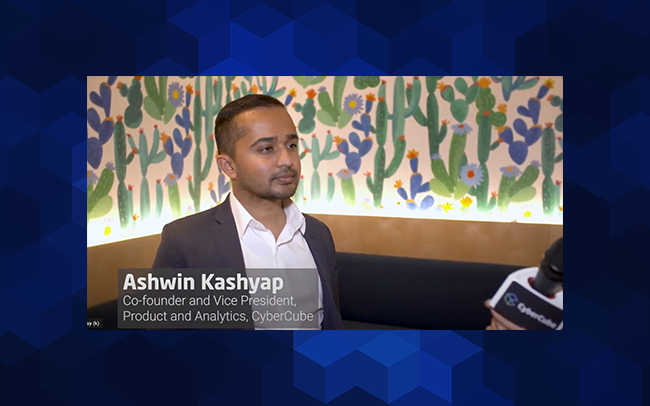Video transcript
The CyberCube webinar on APAC cyber risk and growth trends delves into the opportunities and challenges faced by the cyber insurance and reinsurance market in Asia. It is clear that despite cyber insurance being a relatively new product in the region, its adoption is accelerating rapidly. Factors such as increasing digitalization, the rise in sophisticated cyber threats, and heightened awareness of cybersecurity risks are driving demand across various industries, particularly in countries like Japan, Singapore, and Australia.
Key Insights from the Webinar:
- Cyber Threat Landscape in APAC: William Alman, CyberCube’s Cyber Threat Intelligence Principal, provides an overview of the growing cyber threat landscape in the Asia-Pacific region. Despite the market's rapid growth, there are significant threats to companies, ranging from state-sponsored cyberattacks to criminal activities like ransomware. However, the pace of attacks in APAC is still lower than in the United States, indicating a nascent market in comparison.
- Adoption of Cyber Insurance: While cyber insurance is gaining traction, its uptake is still in the early stages, particularly when compared to more mature markets like the U.S. and Europe. The need for education and awareness within the region is emphasized. A significant gap exists in the preparedness of organizations, with 36% of APAC businesses lacking formal incident response plans. Insurance companies play a crucial role in incentivizing businesses to bolster their cybersecurity measures by promoting the adoption of incident response plans and other risk management strategies.
- Regional Cybersecurity Preparedness: Not all APAC countries are equally prepared for large-scale cyber events. Countries like Malaysia, Singapore, and South Korea rank higher in cybersecurity preparedness, according to the National Cyber Security Index. However, other nations lag behind, making the region a diverse and complex market for cyber insurance.
- Key Cyber Threats: The region faces various cyber threats, including malware, phishing, and distributed denial-of-service (DDoS) attacks. Ransomware remains a significant concern, especially for industries like healthcare, which are highly exposed to cyber risks. CyberCube’s solutions, such as the Account Manager tool, are designed to help insurers assess the risk exposure of organizations by analyzing governance, compliance, and identity access management signals.
- Catastrophic Events and Single Points of Failure (SPoF): APAC has experienced notable cyber incidents, including the Bangladesh Bank Heist in 2016 and the global WannaCry attack in 2017, which affected businesses across the region. CyberCube emphasizes the importance of modeling catastrophic cyber events and assessing the risks posed by single points of failure in the region's critical infrastructure. For example, a DDoS attack on a key healthcare technology provider in Singapore demonstrated the potential for widespread disruption caused by cyberattacks on SPoF technologies.
- Lessons from Mature Markets: APAC markets can benefit from lessons learned in more developed markets like the U.S. and Europe. For example, the decline in ransomware payments in the U.S. is attributed to better data protection and recovery practices. These practices can be adopted in APAC to mitigate the impact of cyberattacks. CyberCube also encourages underwriters in APAC to apply sophisticated catastrophe modeling to better understand and manage cyber risks.
- Nation-State Threats and Ransomware: State-sponsored cyber activity, particularly from Chinese actors, is a significant concern in Southeast Asia. These actors are known for sophisticated tactics, including exploiting vulnerabilities and conducting supply chain attacks. In addition, ransomware is on the rise, with countries like India, Japan, and Singapore being key targets. However, the lack of regulations mandating the reporting of cyber incidents means that the actual number of attacks may be underreported.
- The Role of Reinsurance and Regulation: Reinsurance plays a vital role in supporting the growth of the cyber insurance market in APAC. However, the market remains heavily reinsured, with limited participation from reinsurers. Regulatory frameworks vary across the region, and more mature markets like Singapore, Hong Kong, and Australia have stricter cybersecurity standards compared to developing nations. The webinar highlights the need for greater regulatory harmonization and collaboration among insurers, reinsurers, and technology partners to drive market development.
- Technological Advancements: Emerging technologies, including AI, are shaping the future of cyber insurance in APAC. AI can enhance both risk detection and response capabilities, but it also presents new risks, such as more sophisticated phishing attacks and deepfakes. The adoption of AI-driven models and data analytics can help insurers better quantify and manage cyber risks in the region.
- The Future of Cyber Insurance in APAC: The future of cyber insurance in APAC depends on collaboration between insurers, reinsurers, and other stakeholders. Partnerships between multinational insurers and local companies are essential for advancing the market’s understanding of cyber risks. Additionally, the rise of insurance-linked securities (ILS) in the cyber sector presents new opportunities for capital deployment and risk transfer. The ILS market is growing rapidly, and its involvement in cyber risk signals a broader acceptance of cyber insurance as a mainstream risk category.
In conclusion, the CyberCube webinar underscores the dynamic nature of the cyber insurance market in APAC. While the region faces unique challenges, including varying levels of cybersecurity preparedness and regulatory environments, the growth potential is immense. By leveraging advanced technologies, enhancing collaboration, and learning from mature markets, the APAC cyber insurance market is poised to expand and play a crucial role in mitigating the region’s evolving cyber risks.



